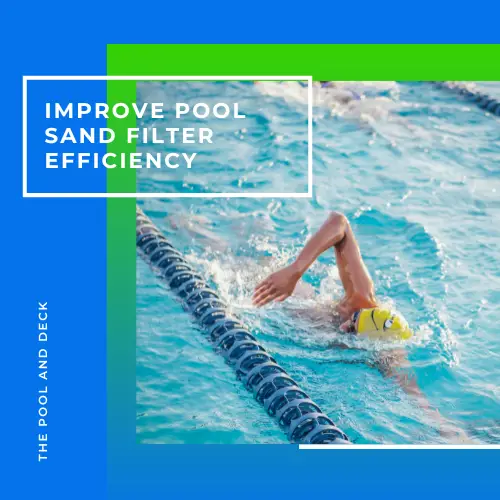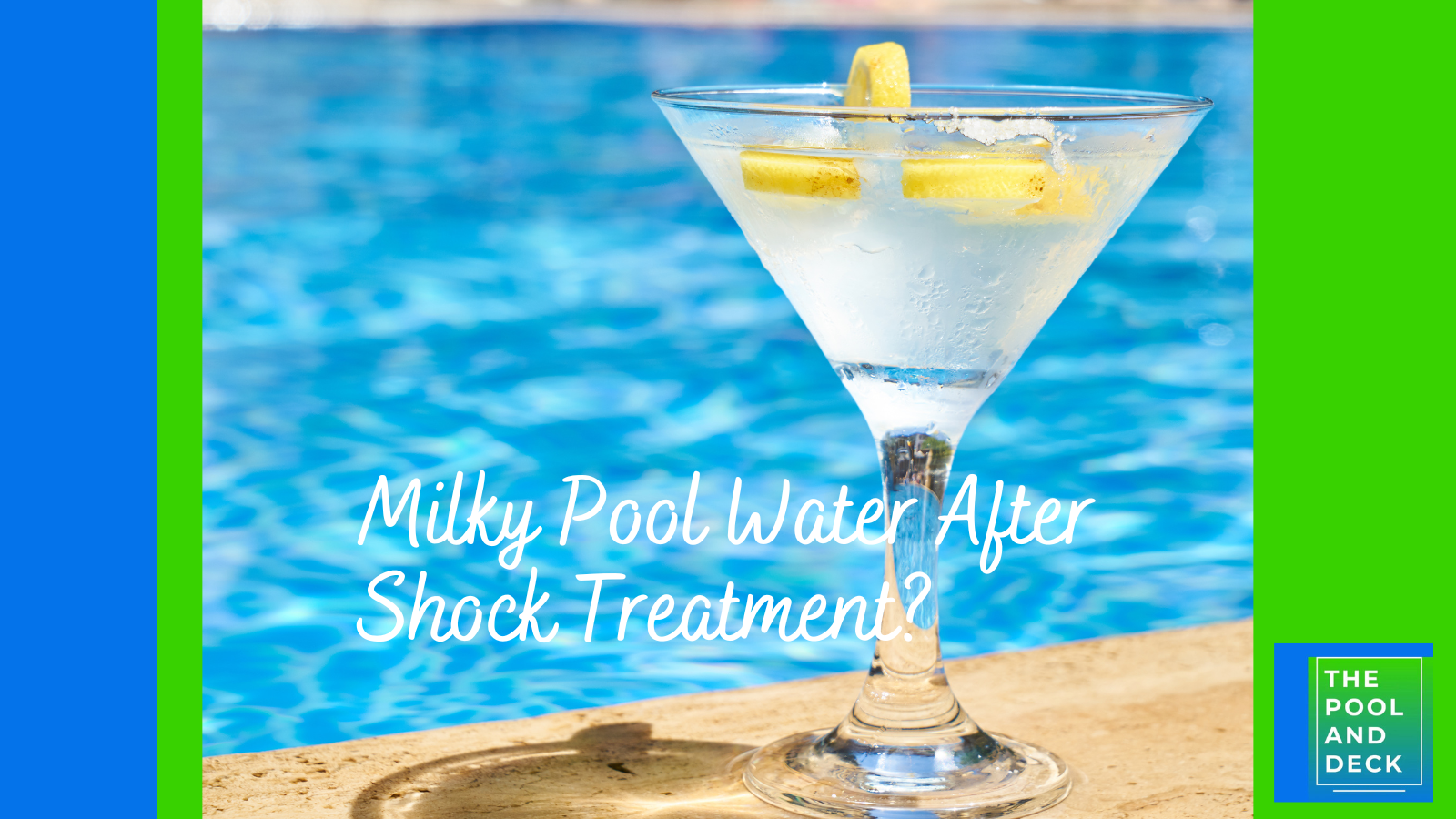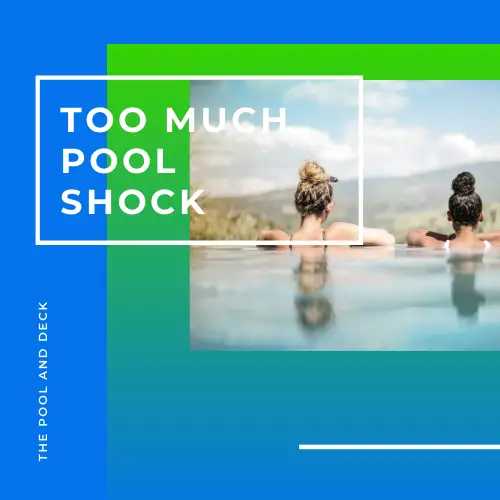How To Improve Pool Sand Filter Efficiency? 11 Terrific Tips!
Table of Contents
How to Improve Pool Sand Filter Efficiency?
To get your dream crystal-clear pool all you may need to do is improve pool sand filter efficiency.
In fact, there are 11 ways to improve pool sand filter efficiency and get more out of your existing filter than you thought was possible. They are simple hacks and they actually work! The best part is that most will not break the bank!
So why settle for mediocre water quality when you can transform your pool into a pristine oasis? Let’s upgrade your sand filter’s performance right away!
Click the relevant link below for a “Specific Tip” or better still read the entire post. It is super informative and helpful!
- Add Some DE Powder to the Sand
- Use Flocculant as Pre-Filter Treatment
- Floc After Shock to Reduce Filter Loading
- Clarifier to Improve Pool Sand Filter Efficiency
- Backwash Regularly
- Use Pool Filter Cleaner at Times
- Descale Pool Filter Sand
- Fix Sand Filter Leaks
- Replace Worn Out Sand
- Upgrade to Sand Alternatives
- Sand Filter & Pump Pairing

As an Amazon Associate, I earn from qualifying purchases.
1. Add Some DE Powder to the Sand
This is a great hack! You can 4X the filtration efficiency of your sand filter by just adding 1 – 3 cups of DE powder to the existing sand in your pool sand filter.
So, how does it work? Essentially, the DE powder forms a layer on top of the sand, creating an even finer filtration layer. This layer is so effective that it can trap particles in the 2 – 5 micron range. Ordinarily the standard No. 20 Silica Sand cannot trap particles smaller than 20 microns.
Recommended Product:
How to add it? Just follow this simple 3 step process:
- Backwash – Backwash your sand filter for 2 minutes, as usual, so that it is as clean as possible
- Rinse – your sand filter for 30 seconds to clear out the last of the debris
- Add DE Powder – Make a slurry of about 1 part DE Filter Aid with about 10 parts water – and pour it slowly into the skimmer nearest to the filter
2. Use Flocculant as Pre-Filter Treatment
You can use the pool flocculant to improve pool sand filter efficiency by giving it a pre-filter treatment. The key ingredient of a pool flocculant is aluminum sulfate, which is an ideal pre-filter treatment too.
How does it work? Aluminum sulfate creates a gel-like layer when mixed with water. The gel settles on top of the sand in the pool filter and helps filter out the bigger contaminants, leaving only the smaller particles for the sand to trap.
How to add it? The process is almost the same as adding DE powder.
- Backwash – Backwash your sand filter for 2 minutes, as usual, so that it is as clean as possible
- Rinse – your sand filter for 30 seconds to clear out the last of the debris
- Add the Floc – Pour a cup of the flocculant into the skimmer nearest to the filter. It will form a gel-like layer on top of the sand in the pool filter
Recommended Product:
3. Floc After Shock to Reduce Filter Loading
If you have had some algae growth, it is not unusual to find that your pool is cloudy after the shock. The cloudiness comes from the dead algae, killed by the shock, floating around in the pool water.
Your first instinct will be to filter out the dead algae, but wait. That may not be the best option. I know it needs time and effort but you are better off using a floc and then vacuuming the pool floor.
This reduces the load on the filter as well as the amount of backwashing required. As a result the life of the sand in the filter is extended.
4. Clarifier to Improve Pool Sand Filter Efficiency
The media most commonly used in a pool sand filter is No. 20 Silica Sand. However, this cannot trap particles smaller than 20 microns. So the smaller particles go through the pool sand filter and come right back into the pool.
The pool clarifier coagulates the smaller particles into bigger clumps, that are larger than 20 microns. These can be trapped by the sand in the pool filter.
The pool clarifier and the pool flocculant have some similarities. Both combine small particles into larger clumps.
The difference is that the particles created by the clarifier remain suspended in the pool and can therefore pass through the pool filter and be trapped.
On the other hand, the particles created by the flocculant sink to the pool floor and must be vacuumed out.
Ultimately, both in their unique ways help to improve pool sand filter efficiency.
5. Backwash Regularly
The job of a pool sand filter is to trap debris, contaminants and algae from your pool. The pool gets cleaned up but the sand in the sand filter accumulates the dirt & debris. Ultimately the filter media reaches its filtration capacity and begins to clog up.
A point is reached when the flow rate drops, the pressure gauge reading climbs up and the pool sand filter is no longer as effective as it used to be.
The solution is to backwash and rinse the filter once the filter pressure reading is around 10 psi higher than the normal psi reading. You may expect to do this 2 – 3 times during the pool season. The frequency may have to be increased to once a week when the bather load is very high.
The proper way to backwash a sand pool filter is as under:
- Turn off the pool pump
- Set the multiport valve (MPV) to “Backwash”
- Turn on the pump
- Backwash for 2 minutes or until the water in the sight glass is running clear
- Turn off the pump
- Set the multiport valve (MPV) to “Rinse”
- Turn on the pump
- Rinse for ½ – 1 minute or until the water in the sight glass is clear
- Turn off the pump
- Set the multiport valve (MPV) to “Filter”
- Turn on the pump
- Check the pool filter pressure
6. Use Pool Filter Cleaner at Times
There are times when simple backwashing is not sufficient. Oils and lotions from swimmers bodies and slimy algae strands are so stuck to the sand particles that backwashing can not dislodge them. In that case you must use a pool filter cleaner.
Please check out the correct way to use it by reading my earlier blog post Pool Sand Filter Cleaner: One-Stop Solution to a Pristine Pool!
Recommended Product:
7. Descale Pool Filter Sand
Calcium is one of the undesirable elements in your pool water. Some of it comes with the fresh water itself while the balance builds up over time, especially if you are using Cal Hypo to shock your pool.
High calcium hardness is never good for your pool. Among other things, it results in scale deposits on pool parts, including the filtration system. This impacts the water flow rate through the pump and the filter.
As the calcium builds up in the filter, it also dries out the sand and causes it to harden. The overall effect is a reduction in the filtration efficiency.
A pool de-scaler should be added to the pool water to keep the calcium hardness at less than 400 ppm. Make sure it enters the pool sand filter by adding it to the skimmer nearest to the filter.
Recommended Product:
8. Fix Sand Filter Leaks
Leaks in the filter or plumbing can cause water to bypass the filter, reducing its effectiveness. There are several spots where a sand filter can leak from.
9. Replace Worn Out Sand
Sand particles are effective as a filter medium only when they have jagged edges and a coarse profile. This helps create irregular pathways within the sand that traps solid particles but lets water pass through.
Over time, the sand particles within the filter become smooth, reducing the filter’s effectiveness at capturing debris and algae. To improve pool sand filter efficiency you must replace the old sand with new.
Check out my post How To Change Pool Filter Sand? (An Easy 10 Step Guide!)
10. Upgrade to Sand Alternatives
While the media most commonly used in a pool sand filter is No. 20 Silica Sand, there are 2 alternatives that have a better performance. When it is time to change the sand filter media, it is worth taking a look at the alternatives.
Check out my earlier blog post on the Best Pool Sand Filter Sand: Top 3 Picks For 2023.
ZeoSand, a Zeolite Pool Filter Media is a good alternative to silica sand. On a weight basis it appears to be more expensive, but in fact it saves you money as it is more effective. You will not only need a lesser quantity but will also save on pool chemicals that get drained out with every backwash.
An even better alternative is glass pool filter sand. It is manufactured from recycled glass and is possibly the best pool sand filter media. In fact, it comes pretty close to increasing the effectiveness of your sand filter to the level of a DE (Diatomaceous Earth) filter.
11. Sand Filter & Pump Pairing
A very important reason for poor filtration efficiency of sand pool filters is the mismatch between the pool size, filter size and pump size.
The diameter of the pool sand filter tank is an indication of the size. However, in fact, the design flow rate (in Gallons Per Minute) of the filter is the true measure of the sand filter size.
The turnover rate (Gallons per 8 Hours) is calculated by multiplying the design flow rate by 480 minutes (8 hours). The filter size must ensure a turnover rate of 2 – 3 times the pool volume for every 8 hours of run time.
Typically a turnover rate of 3 will ensure that around 95% of the pool water would have been filtered at least once. A turnover rate of 2 will ensure that 86% of the pool water would have been filtered at least once.
A turnover rate of less than 2 is sure to result in poor pool filtration efficiency.
Now quite often it is assumed that an oversized, powerful pool pump will improve pool sand filter efficiency. Nothing could be farther than the truth. A pool pump flow rate that is higher than the design flow rate of the sand filter will actually decrease its efficiency.
An oversized pump will push debris through the filter at a rate higher than it can handle. The filter will clog frequently and you will need backwash more often.
Moreover, the high flow rate will form “channels” within the sand that will not be effective in trapping contaminants. The result is that the effective filtration area of the sand media is reduced.
Naturally the pool sand filter efficiency will be compromised. The solution is to replace either the filter or the pump or both, depending on the nature of the mismatch. I must admit that this step will have a high financial cost.
In case you do have an oversized pool pump, consider replacing it with a smaller pump. The sand filter size chart below from my earlier blog post What Is The Perfect Pool Sand Filter Size? Expert Tips! is a good reference point!
But do consult your local pool supplies store first.
Thank you very much for reading the post. I do hope you found it informative and helpful.






